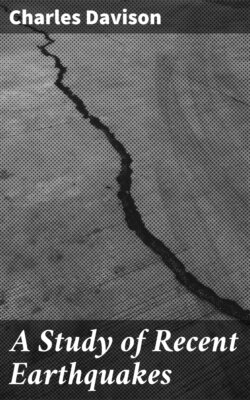Читать книгу A Study of Recent Earthquakes - Charles Davison - Страница 45
На сайте Литреса книга снята с продажи.
ORIGIN OF THE ISCHIAN EARTHQUAKES.
ОглавлениеOn the other hand, the Ischian earthquakes possess several features which connect them closely with true volcanic earthquakes.
1. They originate beneath the northern slope of Epomeo—a volcano that we have no reason to consider absolutely extinct, but rather as one subject to eruptions at long intervals of time—in a region as yet unoccupied by parasitic craters, but having the same relation to the central cone of Epomeo as those in which the recent craters of Monte Rotaro, Montagnone and Cremate are situated.
2. In both the earthquakes of 1881 and 1883, the epicentre is an elongated band, the axis of which, if produced, would pass through the centre of the old crater of Epomeo. Along the line of this band, occur the fumaroles of Monte Cito and Ignazio Verde and the thermal springs of the Rita and Capitello. These facts, as Professor Mercalli suggests, lead us to believe that the foci of the earthquakes coincide with a radial fracture of the volcano, the course of which, as traced by him, is represented by the continuous line in Fig. 14.[27]
3. Except in their relations with actual eruptions, the Ischian earthquakes resemble closely the true volcanic earthquakes which from time to time shake the flanks of Etna. These are marked by great intensity of the shock at the centre of a comparatively small disturbed area, epicentres often elongated radially to the cone, frequent repetition with similar characters in the same districts; and as a rule they precede by a short interval, but sometimes accompany or follow, volcanic eruptions.[28]
Two other phenomena may be referred to as probably indicating some connection between Ischian earthquakes and the structure and history of Epomeo.
We have seen that, in the three earthquakes of 1828, 1881, and 1883, there is distinct evidence of a second meizoseismal area at Fontana, within which the shock was mainly subsultory. Dr. Johnston-Lavis, though recognising the possibility of the existence of two epicentres, prefers another explanation.[29] But the wide extension of the southern boundary of the area of destruction in 1883, and the limitation of several of the after-shocks to the south of the island, seem to me to favour the existence of a second focus beneath the crater of Epomeo, though, it may be, not entirely detached from the chief focus beneath Casamenella.
Again, as Professor Mercalli remarks, all historic eruptions on the flanks of Epomeo were accompanied by very violent earthquakes; while, previously to 1302, only one disastrous earthquake, so far as known, occurred in the island without being attended by an eruption. It should be noticed also that the principal shocks during the recent revival of activity (i.e., since 1762) show a continual increase in intensity, whether this be measured by the damage to buildings, the loss of life, or the extent of the area of destruction (Fig. 14).
It therefore seems legitimate to conclude that, in the recent Ischian earthquakes, we have merely so many unsuccessful attempts to force a new volcanic eruption. The passages once existing through Epomeo and its parasitic craters having become blocked, the highly heated magma beneath is compelled to find a new outlet. Its tension slowly increasing, the crust above is at last rent, or an incipient rent is enlarged, the fluid rock is injected almost instantaneously with great force into the open fissure, and its sudden arrest by the containing walls is the ultimate cause of an earthquake. With the expansion of the magma, its tension is at once correspondingly reduced, and some time must elapse before it can again reach the critical point at which a further rupture, resulting in a second shock, takes place.[30]
Thus, with each great Ischian earthquake, we are, I believe, advancing a step nearer the time, which may be close at hand or may be very remote, when the fracture will at last reach the surface, and above the site of Casamenella a new parasitic cone will rise, from which, as from Cremate in 1302, a stream of lava may flow down towards the sea.
